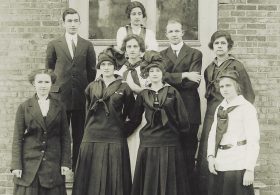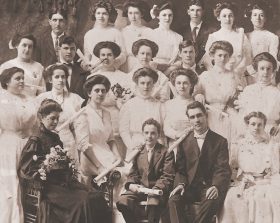There was a time when Elon enforced strict dress codes “for economy and to avoid unpleasant distinctions in dress.”

When students think of dress codes, they might picture a private high school filled with plaid skirts and khakis. Most colleges today do not have dress codes; after all, they are a place where students grapple with individuality and self-discovery. But that was not always the case. Elon was one of many colleges that at one point had a heavily enforced dress code to go along with societal norms.
Starting in the 1890-91 school year, the uniform policy was printed in the Bulletin of Elon College catalog to make students aware of the rules. “For economy and to avoid unpleasant distinctions in dress, young ladies will be required to wear a black uniform. The trimmings and scarfs to be determined by the individual’s taste. It is desired that the quality shall not be expensive, but heavy enough to hold the color and last through the winter,” the rule stated. “Young men need plain and substantial, but not expensive clothing. As a general rule, the more money a student spends on dress the less time is given to study.”
The uniforms were to be worn at any public occasion, which included going to class, to a dining hall and to school-sanctioned events. This was decided in 1890 but there were three changes made to the dress code before it was abolished in 1912. Beginning in 1901-02, the uniforms were determined by the seasons. The Bulletin explained that, “each girl is required to wear for a winter uniform a suit of plain black goods; for the spring white pique skirt and white waist of any kind. The Oxford caps are worn all the year.” Five years later, the women’s uniforms were adjusted yet again. During the fall and spring, they were to wear waists of inexpensive material and plain black or blue-black woolen skirts. During the winter, they were required to wear jackets and skirts made out of the same material. A lot of these changes were made because the college thought they were making it easier on the students if their clothes were inexpensive and looked the same so they could spend more time studying than focusing on appearances.
 Then in 1911-12, the official uniform requirements were eliminated. The school asked students for “simplicity in dress, both for young men and women,” but continued to provide specific dress regulations. Décolleté dresses, for instance, were not permitted. “On all public and evening occasions, except at Commencement, simple white dresses shall be worn,” the rule read. Parents and guardians were asked not to let their daughters spend too much on clothing, noting that the faculty reserved the right to refuse a dress to be worn that they believed to be too expensive or too elaborately made. As societal norms continued to change so did the dress codes.
Then in 1911-12, the official uniform requirements were eliminated. The school asked students for “simplicity in dress, both for young men and women,” but continued to provide specific dress regulations. Décolleté dresses, for instance, were not permitted. “On all public and evening occasions, except at Commencement, simple white dresses shall be worn,” the rule read. Parents and guardians were asked not to let their daughters spend too much on clothing, noting that the faculty reserved the right to refuse a dress to be worn that they believed to be too expensive or too elaborately made. As societal norms continued to change so did the dress codes.
By 1920-21, students were asked to dress simply, and women were allowed to wear evening dresses to formal school occasions. An offer was also extended to parents to have the Dean of Women help them determine “suitable wardrobes for young women” if needed. It wasn’t until the 1935-36 catalog that a dress code was not mentioned at all, giving students the freedom to dress as simple or as complicated as they want to.


